GPF withdrawal rules: If you also invest in GPF, then let us tell you that recently some rules related to withdrawal of money from GPF have been changed, about which you should be aware. The Department of Pension and Pensioners’ Welfare (DoPPW) has recently released the list of GPF withdrawal rules. Read how much amount can be withdrawn now.
Government employees employed before 2004 can invest in GPF i.e. General Provident Fund. It is a savings scheme supported by the central government. If you also invest in this scheme then this news is for you.
Actually, the Central Government has recently changed some rules regarding withdrawal of money related to this scheme, which is important for you to know. Department of Pension and Pensioners Welfare (DoPPW) has recently released the list of GPF withdrawal rules about which we are going to tell you today.
Let us tell you that a customer investing in GPF can withdraw money from the GPF fund for purposes like illness, marriage, education, building a house, buying a car etc. This article has been divided into three groups of reasons so that you can understand it better.
First group of reasons
According to DoPPW, you can withdraw GPF money for the following reasons:
- Education- This includes primary, secondary and higher education which will be applicable to all streams and institutes.
- Mandatory expenses i.e. engagements, weddings, funerals, or other ceremonies of self or family members and dependents.
- Illness of self, family members or dependents
- purchase of consumer durables
For these reasons, as per the rules – GPF subscribers can withdraw twelve months salary or three-fourth of the deposited amount, whichever is less. According to DoPPW, withdrawal of up to 90 per cent of the amount standing to the customer’s account for illness may be allowed. A GPF subscriber can seek withdrawal after completion of ten years of service.
Second group of reasons
You can withdraw money from GPF for the following reasons:
- Purchase of motor car/motorcycle/scooter etc. or repayment of loan already taken for this purpose,
- Comprehensive repair/overhauling of motor cars
- Deposit to book motor car/motorcycle/scooter, moped etc.
For these reasons, as per the rules, a customer may be allowed to withdraw the amount deposited on credit or three-fourth of the cost of the vehicle, whichever is less, for the above purposes. Withdrawal for the above purpose will be allowed only after completion of 10 years of service.
Apart from this, government employees who are to be given superannuation on superannuation two years before retirement are allowed to withdraw up to 90 per cent of the remaining amount without assigning any reason.
Third group of reasons
Construction or acquisition of a suitable house or ready-made flat for residence of the GPF subscriber
- Repayment of outstanding home loan
- Purchasing a home site to build a home
- building a house on acquired land
- Remodeling or making changes to an already purchased home
- Renovation, or alteration of ancestral home
For these reasons, as per the rules, a GPF subscriber may be allowed to withdraw up to 90 per cent of the amount on credit for the above purposes.
According to the current rules, after the sale of the house for which GPF withdrawal has been availed, the amount withdrawn will have to be deposited back.
But now as per the new rules, GPF withdrawal for housing purposes will no longer be linked to the limit prescribed under HBA rules. A customer may be allowed to avail the facility at any time during his service.
What is the eligibility?
- People who are temporary government employees are eligible after 1 year of continuous service.
- Those people who are permanent government employees are eligible.
- People who have been re-employed as retired government pensioners.
- Such government employees who work in establishments covered under the EPF Act, 1952.













